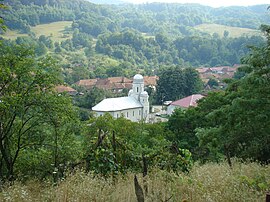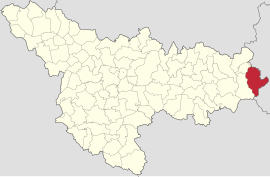Pietroasa, Timiș
Pietroasa | |
|---|---|
 The Lower Orthodox Church in Pietroasa | |
 Location in Timiș County | |
| Coordinates: 45°50′N 22°24′E / 45.833°N 22.400°E | |
| Country | Romania |
| County | Timiș |
| Government | |
| • Mayor (2020–2024) | Virgiliu-Victor Ciocea[1] (PNL) |
Area | 156.46 km2 (60.41 sq mi) |
| Population (2021-12-01)[3] | 1,012 |
| • Density | 6.5/km2 (17/sq mi) |
| Time zone | EET/EEST (UTC+2/+3) |
| Postal code | 307320–307323 |
| Vehicle reg. | TM |
| Website | www |
Pietroasa (Hungarian: Kőfalu; German: Steindorf) is a commune in Timiș County, Romania. It is composed of four villages: Crivina de Sus, Fărășești, Pietroasa (commune seat) and Poieni.
Geography
[edit]Pietroasa is located at the foot of the Poiana Ruscă Mountains, on the Bega River. It is the easternmost commune of Timiș County, bordering Hunedoara County. The nearest town is Făget, 26 km (16 mi) away. It is also one of the largest communes of Timiș County, stretching over 156.46 ha (386.6 acres) of land. Being located in an area of high hills and mountains, the forests occupy 129.06 ha (318.9 acres).[2]
History
[edit]
The first recorded mention of Pietroasa dates from 1514,[4] when it was owned by George of Brandenburg-Ansbach and had 15 serfs.[2] At that time, Pietroasa was part of Marzsina District, which belonged to Hunyad County. In 1597, Sigismund Báthory donated Petroza to Stephen Török, who in 1612 pawned it to Gabriel Bethlen.[2] In 1620, Gabriel Bethlen donated it to Stephen Bethlen Jr.[2] During this period, the locality belonged sometimes to Hunyad County, sometimes to Temes County. The locality appears in the conscription of 1717 under the name of Petrovaz, having 15 houses and being part of Facsád District.[5] After the Treaty of Passarowitz (1718), when Banat came under Habsburg rule, Pietroasa was part, at first, of Facsád District, being mentioned as Petrossa.[2] In 1819 it was donated to Matthew Trattner's family, after which it became the property of the Cika family. In 1890 it received the status of commune seat.
Poieni is located 10 km (6.2 mi) from Pietroasa and is first mentioned in 1514–1516 under the name of Pleyen,[4] when it was owned by George of Brandenburg-Ansbach and had seven serfs.
Crivina de sus, located 4 km (2.5 mi) from Pietroasa, is first mentioned in 1514–1516[4] and, along with Pietroasa and Poieni, was part of the properties of George of Brandenburg-Ansbach.
Fărășești is first mentioned in 1548 under the name of Forrásfalva,[4] as the property of the nobleman John of Bozwar.
Demographics
[edit]Pietroasa had a population of 1,120 inhabitants at the 2011 census, down 5% from the 2002 census. Most inhabitants are Romanians (97.59%). For 2.41% of the population, ethnicity is unknown.[6] By religion, most inhabitants are Orthodox (83.04%), with a minority of Pentecostals (14.55%). For 2.41% of the population, religious affiliation is unknown.[7]
| Census[8] | Ethnic composition | ||||
|---|---|---|---|---|---|
| Year | Population | Romanians | Hungarians | Germans | Ukrainians |
| 1880 | 1,817 | 1,737 | 30 | 39 | – |
| 1890 | 2,032 | 2,008 | 3 | 17 | – |
| 1900 | 2,138 | 2,033 | 49 | 34 | – |
| 1910 | 2,208 | 2,083 | 65 | 16 | 35 |
| 1920 | 1,919 | 1,905 | 12 | 1 | – |
| 1930 | 1,942 | 1,920 | 8 | 11 | – |
| 1941 | 1,760 | 1,752 | 1 | 6 | – |
| 1956 | 1,578 | 1,577 | 1 | – | – |
| 1966 | 1,691 | 1,664 | 20 | – | 2 |
| 1977 | 1,412 | 1,411 | – | – | – |
| 1992 | 1,166 | 1,162 | 1 | – | 1 |
| 2002 | 1,174 | 1,173 | – | – | 1 |
| 2011 | 1,120 | 1,093 | – | – | – |
Economy
[edit]The main source of income for the inhabitants is agriculture, especially animal husbandry. The agricultural lands located on high hills are still worked with animals (horses and oxen), the vegetal production being small but ecological. The threshing of wheat in the villages of Pietroasa and Fărășești is still done with threshers built in the 19th century. In the villages of Crivina de Sus and Poieni, water mills are still used for grinding wheat and corn. The pastures, of low quality and used for raising animals, are extensive but infested with ferns.[2]
Points of interest
[edit]- Crivina de Sus wooden church (1676)
- Pietroasa wooden church (1779)
- Poieni wooden church (1759)
- 370-meter-long (1,210 ft) Blue Cave, known as such due to a chromatic dominance ("Pietroasa blue")[9]
- former millstone quarries on Dealul Pietrii (18th century)[9][10]
- Șopot Waterfall
-
Crivina de Sus wooden church
-
Pietroasa wooden church
-
Poieni wooden church
References
[edit]- ^ "Results of the 2020 local elections". Central Electoral Bureau. Retrieved 16 June 2021.
- ^ a b c d e f g "Prezentare locală". Primăria comunei Pietroasa.
- ^ "Populaţia rezidentă după grupa de vârstă, pe județe și municipii, orașe, comune, la 1 decembrie 2021" (XLS). National Institute of Statistics.
- ^ a b c d Szabó, M. Attila (2003). Erdély, Bánság és Partium történeti és közigazgatási helységnévtára. Miercurea Ciuc: Pro-Print Kiadó.
- ^ Pesty, Frigyes (1884). Krassó vármegye története (PDF). Vol. II. Budapest: Athenaeum R. Társ. Könyvnyomdája. pp. 108–109.
- ^ a b "Tab8. Populația stabilă după etnie – județe, municipii, orașe, comune". Institutul Național de Statistică.
- ^ a b "Tab13. Populația stabilă după religie – județe, municipii, orașe, comune". Institutul Național de Statistică.
- ^ Varga, E. Árpád. "Temes megye településeinek etnikai (anyanyelvi/nemzetiségi) adatai 1880-2002" (PDF).
- ^ a b Păun, Liana (20 December 2020). "Comorile turistice ale Timișului – de la "Delta Banatului" la bisericuțele de lemn". pressalert.ro.
- ^ Țăranu, Nicolae (1979). "Cioplitul pietrelor de moară în Pietroasa (jud. Timiș)" (PDF). StCEI. 3: 149–156.





